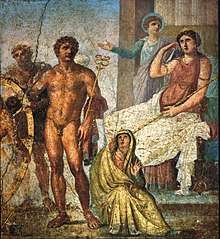Nephele
In Greek mythology, Nephele (/ˈnɛfəliː/; Greek: Νεφέλη, from νέφος nephos "cloud";[1] Latinized to Nubes) was a cloud nymph who figured prominently in the story of Phrixus and Helle.[2]
| Nephele | |
|---|---|
Cloud nymph | |
| Member of the Athamantian Royal House | |
 Punishment of Ixion: Nephele sitting at Mercury's feet. Roman fresco in the House of the Vettii Pompeii | |
| Abode | Athamantia in Boeotia |
| Consort | Athamas |
| Offspring | Phrixus and Helle |
Mythology
Greek myth has it that Nephele is the cloud whom Zeus created in the image of Hera to trick Ixion to test his integrity after displaying his lust for Hera during a feast as a guest of Zeus. Ixion's restraint failed him, and he coupled with Nephele, eventually fathering the Centaurs (through Imbros[3] or Centauros[4]).
Nephele married Athamas, and had twins, a son Phrixus and a daughter Helle. Athamas then divorced her for Ino, who hatched a devious plot to get rid of the twins, roasting all the town's crop seeds so they would not grow. The local farmers, frightened of famine, asked a nearby oracle for assistance. Ino bribed the men sent to the oracle to lie and tell the others that the oracle required the sacrifice of Phrixus. Before he was killed though, Phrixus and Helle were rescued by a flying golden ram sent by their natural mother Nephele.
Phrixus and Helle were instructed to not look down to Earth for the duration of their flight. Helle, though, did look down, and fell off the ram into the Hellespont (which was named after her, meaning Sea of Helle) and drowned, but Phrixus survived all the way to Colchis, where King Aeetes took him in and treated him kindly, giving Phrixus his daughter, Chalciope, in marriage. In gratitude, Phrixus gave the king the Golden Fleece of the ram, which Aeetes hung in a tree in his kingdom. The Golden Fleece would later be taken by Jason and his Argonauts.
See also
References
- R. S. P. Beekes, Etymological Dictionary of Greek, Brill, 2009, p. 1012.
- Hyginus (Mary Grant translation): The Ram, (Aries)
- Tzetzes, Chiliades 9.20 line 464, 469 & 477
- Pseudo-Apollodorus, Bibliotheca Epitome of Book 4.1.20